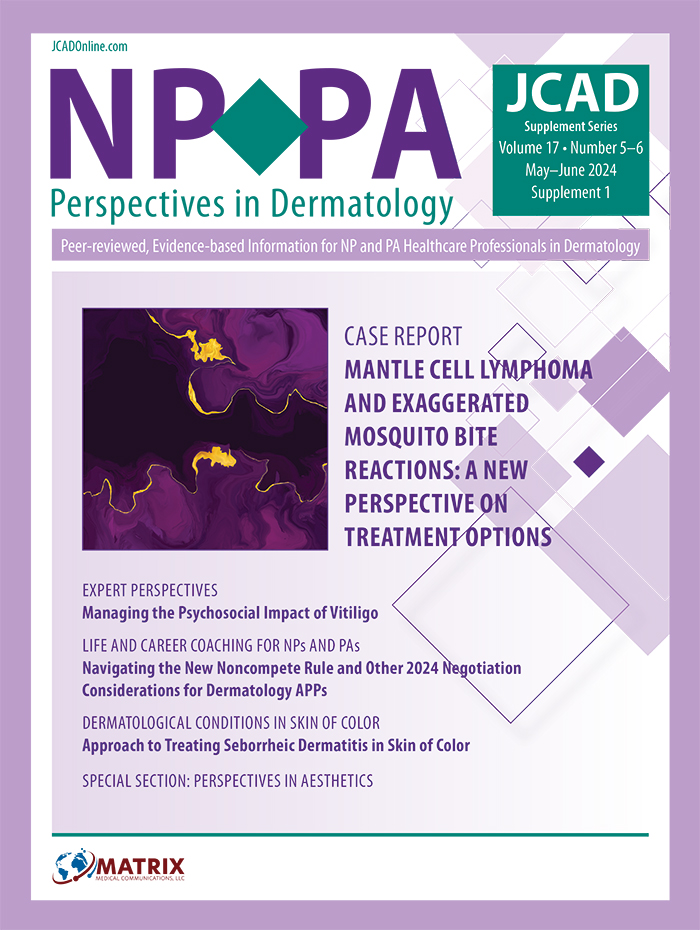
Interested in submitting an article to NP+PA Perspectives in Dermatology? Here are some key steps to follow when preparing a manuscript.
Step 1: Picking a Topic
Not sure what to write about? Pick something you find interesting! As nurse practitioners and physician assistants, you see many patients per day and experience a whole range of dermatological conditions. Writing should be fun, so selecting a topic that intrigues you will make you more likely to finish a manuscript.
Step 2: Picking an Article Type
There are no limitations on the type of article that can be submitted to NP+PA Perspectives in Dermatology, but especially if you don’t have a lot of experience writing for peer-reviewed journals, start with something on the shorter side. This could be a case report, a commentary, or a brief report on a topic. Length-wise, these are all pretty similar—about 1,000 to 1,500 words on average with about 10 to 15 references. These are not firm rules though, so feel free to write a little more if you have more to say.
Case reports (or case series, if you want to include information from several patients) are usually the most ideal choice because it allows you to write about something interesting that happened at your clinic. Commentaries are good because they can be about any topic and can include your opinion, as long as it’s backed up by research. Brief reports are a more formal version of this and can include original research in a condensed format.
Original research and review articles tend to be much longer (as long as 5,000 words), but don’t feel like you have to produce something like this. While we will still accept these article types, they require a lot more work to produce and might be better suited for more experienced writers.
Letters to the editor are welcome too. These are usually short (think 500 to 750 words) and are opinion-based pieces on something that has been published elsewhere. Or, you could even respond to an article that was published previously in our journal.
Step 3: Writing the article
Our journal follows the style of the American Medical Association (AMA), which means we include a numbered reference list at the end of the article, with the numbers coming after the sections that correspond with each reference. Do not alphabetize your references—this is common in other writing formats such as MLA. We will ask you to reformat it to AMA style.
Everyone’s writing style is different, but making an outline usually helps to keep you organized and on track. Not every article type will require an abstract, but even a short one is often helpful. Also pick out some keywords—we recommend 3 to 5 total. However, it might be easier to leave the abstract and keywords until the end. You might find new information throughout your research process that slightly changes the scope of what you’re writing about, so this saves you time from constantly having to rewrite the abstract.
Do some research! Look through PubMed and any other medical journal databases you like. Collect a group of articles that seem relevant to your topic and highlight some key points. It’s OK if you don’t use them all, but it gives you a foundation for what to focus no later.
Step 4: Submitting the article
We process our article submissions through a platform called Editorial Manager. To submit the article, click here and follow the instructions to create a profile if it’s your first time submitting.
Cover letter. Create a 1-page cover letter that briefly outlines the article type, confirm that the article is not under consideration by any other journals, and disclose any financial disclosures or conflicts of interest. Also include all author names, their affiliations, and a corresponding author’s email address.
Manuscript. The actual article will be its own document as well. Make sure it includes a title, any relevant figures or tables (not required), and correctly formatted references. The article should be double spaced as well.
Author/Copyright Forms. Both forms are available on Editorial Manager, and you will be prompted to fill them out. Each author must fill out a separate author form, but all authors can sign the same copyright form.
What happens next?
The article will get assigned to peer reviewers, who will assess the quality of your article and determine if it’s suitable for publication. This process usually takes between 1 and 3 months, depending on the speed of the reviewers and time of year. Once the reviewers come to a decision, you will receive a decision letter via Editorial Manager.
If the article is accepted as is, it will get slated for a specific issue. If it’s accepted with revisions, you will be asked to make the revisions, and the article will be slated for an issue once the updated version is submitted. If it requires heavier revisions and re-review, you will be given a list of things to revise and the chance to resubmit for peer review. If the article is outright rejected, you will be given a reason why, but you will not have a chance to resubmit. This can happen if the article topic is not relevant, if it has glaring issues with reference inclusion, or if it is poorly written.
Frequently asked questions
Q: Who is eligible to submit an article?
A: You must be a nurse practitioner or physician assistant.
Q: Can I include co-authors?
A: Yes! There is no limit to the number of authors for an article. In fact, you can even co-write with a physician if you’d like. Just make sure the first author is an NP or PA.
Q: Can I submit an article that has been published elsewhere?
A: No, it cannot be published on another website or in another medical journal.
Additional Notes
For more detailed information, you can view the full JCAD author guidelines here. If you have any other specific questions, feel free to email our Managing Editor, Austin Vitelli.